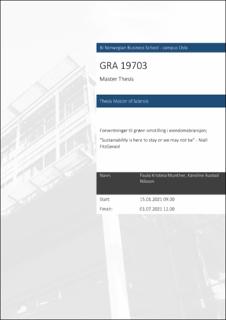Forventninger til grønn omstilling i eiendomsbransjen; “Sustainability is here to stay or we may not be” - Niall FitzGerald
Master thesis
Permanent lenke
https://hdl.handle.net/11250/2789400Utgivelsesdato
2021Metadata
Vis full innførselSamlinger
- Master of Science [1621]
Sammendrag
This thesis aims to identify key risk factors for the real estate industry in Norway,
by implementing a new classification system for sustainable investment, the
Taxonomy Regulation. Since European legal climate acts are increasing in scope
and complexity, an interdisciplinary assessment will be required, of both direct and
indirect activities, contributing to mitigate climate risk.
The research methodology is based on a scenario analysis, founded in empirical
data. Data collection is conducted using qualitative interviews as well as a
quantitative survey. The data material is analyzed using a Grounded Theory
analysis, based on step-by-step coding. The qualitative codes are quantified to form
measurable values, which can be used to rank the risk factors. The ranked values
are further used in identifying critical uncertainties in the industry.
The results from the qualitative analysis, combined with the standard deviation
from the quantitative survey, presents; government requirements, strategy
development and level of knowledge as the transformative risk factors for the real
estate industry. Secondly, circular economy, transition risk and generational
change have been identified as trends that will have a dynamic effect on the drivers
over time. The risk factors then form the axes in a final 2x2 scenario matrix.
Based on discussion of which risk factors are rational, it was concluded that if the
real estate industry is to contribute to mitigate climate change, they must focus on
governmental regulation and strategy development. These are risk factors that can
increase the understanding of how climate decisions that the real estate industry
makes today, can create opportunities and pitfalls in the future.
Beskrivelse
Masteroppgave(MSc) in Master of Science in Business Law
